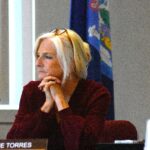The late President John F. Kennedy announced March 28, 1961 that 50 defense bases would be closed by the first of October of the same year in order to gear the nation for nuclear defense. One of the bases affected was the 802nd Strategic Missile Wing located at the Presque Isle Air Force Base. The $12 million facility, which based the only SNARK Wing in the world, was being deactivated as the $680 million program was obsolete and of marginal military value.
In 1961, Mrs. Augusta K. Christie, a senate member, Mr. John Henchevy, Presque Isle city manager, and Harold Stewart, state representative, were credited with starting the process to establish an educational institute. The bill that was eventually passed was championed by Stewart and former State Senator E. Perrin Edmunds. It was signed by the governor June 17, 1961, establishing an institute in the deactivated buildings of the missile base in Presque Isle with 87 acres of land and over 36 buildings.
A committee of 10 individuals worked closely with the local elected officials to both get the property transferred from the federal government and to ensure the state legislation that established what is present-day Northern Maine Community College was passed. Former state senator and well-known lawyer and community leader Floyd Harding was among the core members of the group, considered today to be “founders” of the institution.
“We knew that a vocational school was greatly needed in our area and that the former base buildings that housed the carpentry, electric, plumbing and automotive shops would be good facilities to start such training and education programs,” said Harding. “It was a challenge to get the legislation passed, but we did it. We knew that if we persisted that generations of future county residents would benefit from what we did. That has certainly rung true today as more than 7,500 graduates of the college have made a decent living because of what the school and its faculty and staff have imparted on them. I am always pleased at the frequency with which I hear such positive comments about the college from those whose lives have been transformed by their education at Northern Maine Community College.”
The bill, which Stewart, Edmunds, Harding and his fellow committee members supported, provided for funds for opening the institute, but they were insufficient for opening the doors for students. Therefore the official opening would wait until 1963. Mr. Keith Thompson, an educator and native of Presque Isle, was appointed the first principal of the institute. At the very beginning of the institute’s history, the name was Northeastern Maine Vocational Institute (NMVI).
In March 1963, the Practical Nursing Program was transferred to the Institute from the Aroostook State College. In the fall of 1963, the doors were opened to 78 students enrolled in four courses – automotive service, carpentry construction, electrical construction, and practical nursing. The fifth program, sheet metal, was added to the curriculum during the summer of 1964. Auto body repair and secretarial science were added in 1965. In 1966, drafting, radio TV repair and service, and masonry were added with an accounting course beginning in 1967.
A library was established in 1968 and was located in what was formerly known as the NCO Mess Hall. Previous to this, faculty members operated a self-service type library.
The first permanent building was completed in August 1970, and the administration and business education departments moved into the new quarters. It was to be the Augusta K. Christie Building. This building was named in honor of the legislator’s interests and vision in vocational education.
Ralph K. Sylvester, who was named the second administrative head or director of the school in 1964, resigned in 1969 and Harold L. Mailman, former coordinator of vocational education programs with the State Bureau of Vocational Education, was appointed as the new director. Mr. Mailman, at the beginning of the 1969-70 academic year, welcomed 299 students to the campus.
The 100th Legislature recognized the need for more adequate dormitory space if the institute was to continue to grow in terms of student enrollment. On June 6, 1970, the public passed the referendum for the dormitory which was designed to hold 80-100 students and named the Roland B. Andrews Residence Hall.
Northern Maine Vocational Technical Institute was approved to offer associate degrees in business education in the areas of accounting and secretarial science in 1970. The plumbing and heating and computer programming programs were added to the institute’s offerings in January 1972, thus making a total of 13 occupational courses.
To help utilize all facilities available, the University of Maine at Presque Isle and then NMVTI worked cooperatively beginning to interchange courses and credits between the institutions. The institute became accredited for a three-year period effective October 1975.
The 106th Legislature provided funds for the third permanent building, a building trades shop (Mailman Trades Building). Construction began in May 1974, and students began using this facility in January 1975. The addition of the new facility provided an ideal working space for a new project between the college and the Presque Isle Kiwanis Club. In 1976, the Sinawik (Kiwanis spelled backward) project was launched and the first home was constructed at then NMVTI for a county family. The project featured the work of five college programs: drafting, residential construction, plumbing and heating, electrical construction, and metal fabrication.
During the summer of 1976, an addition was constructed on the east end of the auto body shop by a contractor. On Dec. 27, a fierce wind, snow, rain and sleet storm blew down the addition of the auto body shop. The insurance money was used to tear down the remainder of the building and to erect in its place a metal building properly designed for a first-class auto body training facility. This building was complete in the fall of 1977. Today, NMCC is one of only two colleges in the northeast to offer a program in auto collision repair.
During the 108th Legislature, members of the Aroostook legislative delegation were successful in amending a proposed bill to include a multi-purpose instructional building for NMVTI. Voters in December 1977 approved the bond referendum, and the building was completed in 1979 and houses the gymnasium.
In the fall of 1977, a wood harvesting program was initiated and a fire academy was organized. These two programs required the opening of a closed dormitory (Dormitory 210). This building was being used to house 16 wood harvesting students during the winter of 1977-78 when on Feb. 2, 1978, a fire broke out which destroyed approximately 40 percent of the building. Fortunately, all students evacuated the building safely. It was due to this fire that NMVTI acquired an apartment-style dormitory which was completed in 1980. Also completed in 1980 was a food service building (Reed Dining Commons) which replaced the snack bar and cafeteria remaining from the military.
Maine people then voted to close four old military buildings which housed four occupational programs and to erect a mechanical trades building. The building was completed in 1982, and the programs plumbing and heating, welding, diesel hydraulic technology, and automotive technology moved in.
With the resignation of Harold Mailman as director in 1979, James C. Patterson, assistant director, was named acting director for the 1979-80 academic year. Richard M. Knight was appointed the fourth director of NMVTI following Patterson’s interim year. He served until February of 1984 and was followed by Patterson, who was appointed the institution’s fifth director.
In 1981, NMVTI offered programs in 17 occupational fields. NMVTI also was one of two institutions in the state authorized to offer the small business administration course. During the same year, NMVTI received final approval to implement an associate degree nursing (ADN) upgrade program from the licensed practical nursing (LPN) program which enables graduates to sit for RN licensure. NMVTI was the first VTI in the state to begin this program during the 1981-82 school year when 20 students started in the program.
With the addition of the ADN program, a one-year program, and the small computer systems program, NMVTI offered 19 occupational programs in the fall of 1981. Enrollment reached the all time high with 577 students, over 3,000 in adult education. Instructional staff numbered 49 and the total number of employees stood at 93.
As NMVTI entered the mid-1980s, continual upgrading of programs to meet current and future technical needs was evident. The consumer electronics program was changed to computer electronics, auto mechanics became automotive technology, a small computer systems major was added, and an important change in the health occupations area was made with the addition of an associate degree nursing program.
The associate degree nursing program provided an opportunity for licensed practical nurses to acquire the new knowledge and skills necessary to perform as registered nurses. NMVTI’s program, which enabled graduates to take the NCLEX examination for licensure as registered nurses, helped area hospitals face the shortage of registered nurses in the 1980s. The shortage continues nationally today, but has been less severe in northern Maine through the efforts of NMCC. Today, more the 50 percent of nurses working in Aroostook County hospitals are graduates of NMCC.
In November 1984, Maine voters approved a bond issue for the VTI’s which allowed for the construction of two wings to the Christie Building. A new 90-seat lecture hall/auditorium was added to the facility at that time. When the south end addition was complete in 1986, the library was moved from an old military building into the facility and the nursing department was moved into the second level above the library. The north wing extension was occupied by the electrical and electronic programs when it was completed in the fall of 1987.
In 1987, there were 11 new permanent buildings on the NMCC campus: a classroom/administration facility (Christie Building), a residence hall (Andrews Hall), a building trades and related construction lab (Mailman Trades Building), an auto body/auto collision repair lab, a multi-purpose building (gymnasium and classrooms), a residence complex – including a cafeteria (Reed Dining Commons) and three apartment-style buildings (Aroostook, Penobscot and Washington Halls), a mechanics trade building, and a nursing wing.
In 1988, only the masonry program remained in a military building. The bookstore, maintenance department, and purchasing and receiving were also still located in government buildings. The former home of the base commander, which had at times served as the residence for the campus director and also as an energy-related experimental laboratory, became the office of the director of the institute. Not only would the physical location of the director’s office change, but the person occupying the seat would, as well. In April of 1986, James Patterson resigned as director and Dr. William Warren, who served as assistant director of Southern Maine Vocational Technical Institute, was appointed interim director for the Presque Isle campus. The sixth director, Durward R. Huffman, began his tenure in September of 1986. Huffman would not only serve as the last director of NMVTI, he would become the first president of Northern Maine Technical College, and later be one of the leading architects, at the system-level, for the present-day Maine Community College System.
Editor’s note: NMCC will celebrate its 50th anniversary between 2011 (the anniversary of the 1961 legislation establishing the college) and 2013 (the anniversary of the first entering class in 1963). Campus and community members are in the early stages of planning for the 50th anniversary celebration, which will include a new publication on the history of Maine’s northernmost college.
In 1961, Mrs. Augusta K. Christie, a senate member, Mr. John Henchevy, Presque Isle city manager, and Harold Stewart, state representative, were credited with starting the process to establish an educational institute. The bill that was eventually passed was championed by Stewart and former State Senator E. Perrin Edmunds. It was signed by the governor June 17, 1961, establishing an institute in the deactivated buildings of the missile base in Presque Isle with 87 acres of land and over 36 buildings.
A committee of 10 individuals worked closely with the local elected officials to both get the property transferred from the federal government and to ensure the state legislation that established what is present-day Northern Maine Community College was passed. Former state senator and well-known lawyer and community leader Floyd Harding was among the core members of the group, considered today to be “founders” of the institution.
“We knew that a vocational school was greatly needed in our area and that the former base buildings that housed the carpentry, electric, plumbing and automotive shops would be good facilities to start such training and education programs,” said Harding. “It was a challenge to get the legislation passed, but we did it. We knew that if we persisted that generations of future county residents would benefit from what we did. That has certainly rung true today as more than 7,500 graduates of the college have made a decent living because of what the school and its faculty and staff have imparted on them. I am always pleased at the frequency with which I hear such positive comments about the college from those whose lives have been transformed by their education at Northern Maine Community College.”
The bill, which Stewart, Edmunds, Harding and his fellow committee members supported, provided for funds for opening the institute, but they were insufficient for opening the doors for students. Therefore the official opening would wait until 1963. Mr. Keith Thompson, an educator and native of Presque Isle, was appointed the first principal of the institute. At the very beginning of the institute’s history, the name was Northeastern Maine Vocational Institute (NMVI).
In March 1963, the Practical Nursing Program was transferred to the Institute from the Aroostook State College. In the fall of 1963, the doors were opened to 78 students enrolled in four courses – automotive service, carpentry construction, electrical construction, and practical nursing. The fifth program, sheet metal, was added to the curriculum during the summer of 1964. Auto body repair and secretarial science were added in 1965. In 1966, drafting, radio TV repair and service, and masonry were added with an accounting course beginning in 1967.
A library was established in 1968 and was located in what was formerly known as the NCO Mess Hall. Previous to this, faculty members operated a self-service type library.
The first permanent building was completed in August 1970, and the administration and business education departments moved into the new quarters. It was to be the Augusta K. Christie Building. This building was named in honor of the legislator’s interests and vision in vocational education.
Ralph K. Sylvester, who was named the second administrative head or director of the school in 1964, resigned in 1969 and Harold L. Mailman, former coordinator of vocational education programs with the State Bureau of Vocational Education, was appointed as the new director. Mr. Mailman, at the beginning of the 1969-70 academic year, welcomed 299 students to the campus.
The 100th Legislature recognized the need for more adequate dormitory space if the institute was to continue to grow in terms of student enrollment. On June 6, 1970, the public passed the referendum for the dormitory which was designed to hold 80-100 students and named the Roland B. Andrews Residence Hall.
Northern Maine Vocational Technical Institute was approved to offer associate degrees in business education in the areas of accounting and secretarial science in 1970. The plumbing and heating and computer programming programs were added to the institute’s offerings in January 1972, thus making a total of 13 occupational courses.
To help utilize all facilities available, the University of Maine at Presque Isle and then NMVTI worked cooperatively beginning to interchange courses and credits between the institutions. The institute became accredited for a three-year period effective October 1975.
The 106th Legislature provided funds for the third permanent building, a building trades shop (Mailman Trades Building). Construction began in May 1974, and students began using this facility in January 1975. The addition of the new facility provided an ideal working space for a new project between the college and the Presque Isle Kiwanis Club. In 1976, the Sinawik (Kiwanis spelled backward) project was launched and the first home was constructed at then NMVTI for a county family. The project featured the work of five college programs: drafting, residential construction, plumbing and heating, electrical construction, and metal fabrication.
During the summer of 1976, an addition was constructed on the east end of the auto body shop by a contractor. On Dec. 27, a fierce wind, snow, rain and sleet storm blew down the addition of the auto body shop. The insurance money was used to tear down the remainder of the building and to erect in its place a metal building properly designed for a first-class auto body training facility. This building was complete in the fall of 1977. Today, NMCC is one of only two colleges in the northeast to offer a program in auto collision repair.
During the 108th Legislature, members of the Aroostook legislative delegation were successful in amending a proposed bill to include a multi-purpose instructional building for NMVTI. Voters in December 1977 approved the bond referendum, and the building was completed in 1979 and houses the gymnasium.
In the fall of 1977, a wood harvesting program was initiated and a fire academy was organized. These two programs required the opening of a closed dormitory (Dormitory 210). This building was being used to house 16 wood harvesting students during the winter of 1977-78 when on Feb. 2, 1978, a fire broke out which destroyed approximately 40 percent of the building. Fortunately, all students evacuated the building safely. It was due to this fire that NMVTI acquired an apartment-style dormitory which was completed in 1980. Also completed in 1980 was a food service building (Reed Dining Commons) which replaced the snack bar and cafeteria remaining from the military.
Maine people then voted to close four old military buildings which housed four occupational programs and to erect a mechanical trades building. The building was completed in 1982, and the programs plumbing and heating, welding, diesel hydraulic technology, and automotive technology moved in.
With the resignation of Harold Mailman as director in 1979, James C. Patterson, assistant director, was named acting director for the 1979-80 academic year. Richard M. Knight was appointed the fourth director of NMVTI following Patterson’s interim year. He served until February of 1984 and was followed by Patterson, who was appointed the institution’s fifth director.
In 1981, NMVTI offered programs in 17 occupational fields. NMVTI also was one of two institutions in the state authorized to offer the small business administration course. During the same year, NMVTI received final approval to implement an associate degree nursing (ADN) upgrade program from the licensed practical nursing (LPN) program which enables graduates to sit for RN licensure. NMVTI was the first VTI in the state to begin this program during the 1981-82 school year when 20 students started in the program.
With the addition of the ADN program, a one-year program, and the small computer systems program, NMVTI offered 19 occupational programs in the fall of 1981. Enrollment reached the all time high with 577 students, over 3,000 in adult education. Instructional staff numbered 49 and the total number of employees stood at 93.
As NMVTI entered the mid-1980s, continual upgrading of programs to meet current and future technical needs was evident. The consumer electronics program was changed to computer electronics, auto mechanics became automotive technology, a small computer systems major was added, and an important change in the health occupations area was made with the addition of an associate degree nursing program.
The associate degree nursing program provided an opportunity for licensed practical nurses to acquire the new knowledge and skills necessary to perform as registered nurses. NMVTI’s program, which enabled graduates to take the NCLEX examination for licensure as registered nurses, helped area hospitals face the shortage of registered nurses in the 1980s. The shortage continues nationally today, but has been less severe in northern Maine through the efforts of NMCC. Today, more the 50 percent of nurses working in Aroostook County hospitals are graduates of NMCC.
In November 1984, Maine voters approved a bond issue for the VTI’s which allowed for the construction of two wings to the Christie Building. A new 90-seat lecture hall/auditorium was added to the facility at that time. When the south end addition was complete in 1986, the library was moved from an old military building into the facility and the nursing department was moved into the second level above the library. The north wing extension was occupied by the electrical and electronic programs when it was completed in the fall of 1987.
In 1987, there were 11 new permanent buildings on the NMCC campus: a classroom/administration facility (Christie Building), a residence hall (Andrews Hall), a building trades and related construction lab (Mailman Trades Building), an auto body/auto collision repair lab, a multi-purpose building (gymnasium and classrooms), a residence complex – including a cafeteria (Reed Dining Commons) and three apartment-style buildings (Aroostook, Penobscot and Washington Halls), a mechanics trade building, and a nursing wing.
In 1988, only the masonry program remained in a military building. The bookstore, maintenance department, and purchasing and receiving were also still located in government buildings. The former home of the base commander, which had at times served as the residence for the campus director and also as an energy-related experimental laboratory, became the office of the director of the institute. Not only would the physical location of the director’s office change, but the person occupying the seat would, as well. In April of 1986, James Patterson resigned as director and Dr. William Warren, who served as assistant director of Southern Maine Vocational Technical Institute, was appointed interim director for the Presque Isle campus. The sixth director, Durward R. Huffman, began his tenure in September of 1986. Huffman would not only serve as the last director of NMVTI, he would become the first president of Northern Maine Technical College, and later be one of the leading architects, at the system-level, for the present-day Maine Community College System.
Editor’s note: NMCC will celebrate its 50th anniversary between 2011 (the anniversary of the 1961 legislation establishing the college) and 2013 (the anniversary of the first entering class in 1963). Campus and community members are in the early stages of planning for the 50th anniversary celebration, which will include a new publication on the history of Maine’s northernmost college.







